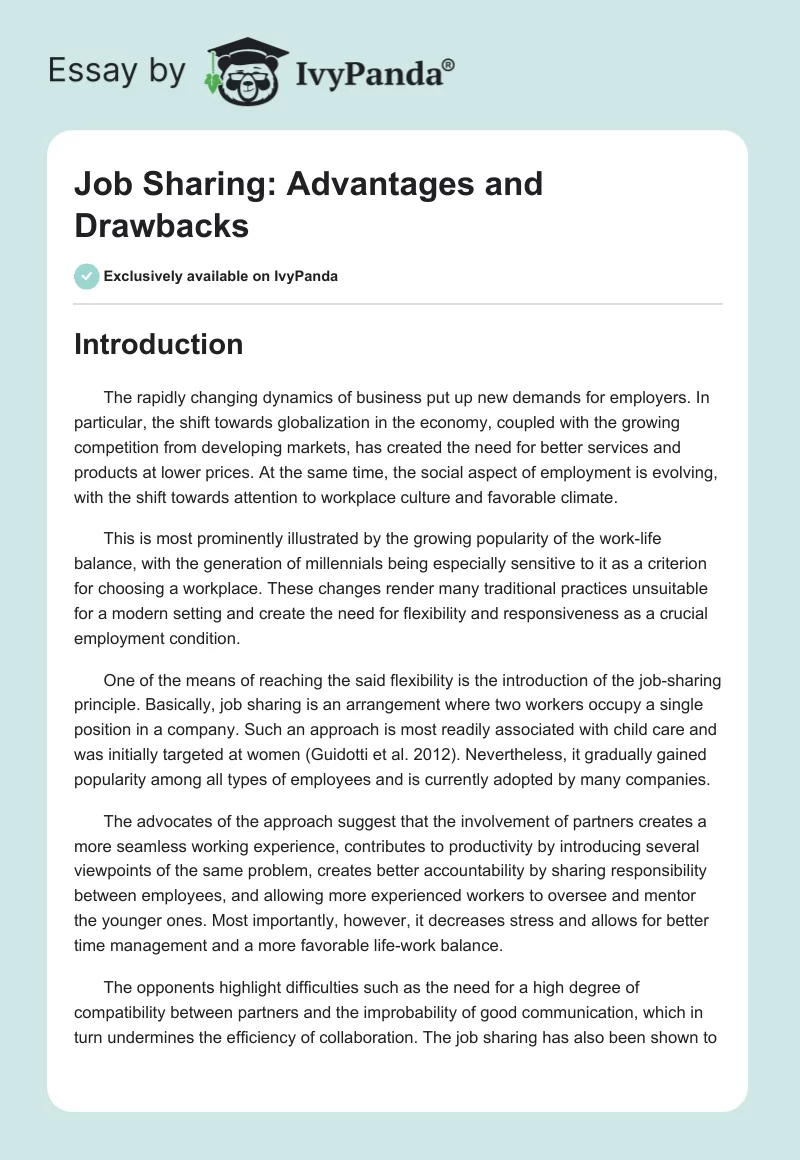Introduction
The rapidly changing dynamics of business put up new demands for employers. In particular, the shift towards globalization in the economy, coupled with the growing competition from developing markets, has created the need for better services and products at lower prices. At the same time, the social aspect of employment is evolving, with the shift towards attention to workplace culture and favorable climate.
This is most prominently illustrated by the growing popularity of the work-life balance, with the generation of millennials being especially sensitive to it as a criterion for choosing a workplace. These changes render many traditional practices unsuitable for a modern setting and create the need for flexibility and responsiveness as a crucial employment condition.
One of the means of reaching the said flexibility is the introduction of the job-sharing principle. Basically, job sharing is an arrangement where two workers occupy a single position in a company. Such an approach is most readily associated with child care and was initially targeted at women (Guidotti et al. 2012). Nevertheless, it gradually gained popularity among all types of employees and is currently adopted by many companies.
The advocates of the approach suggest that the involvement of partners creates a more seamless working experience, contributes to productivity by introducing several viewpoints of the same problem, creates better accountability by sharing responsibility between employees, and allowing more experienced workers to oversee and mentor the younger ones. Most importantly, however, it decreases stress and allows for better time management and a more favorable life-work balance.
The opponents highlight difficulties such as the need for a high degree of compatibility between partners and the improbability of good communication, which in turn undermines the efficiency of collaboration. The job sharing has also been shown to undermine equal opportunity, introduce additional expenses, and complicate external overseeing.
Benefits of Job Sharing
For the organization, the benefits of job sharing can be grouped into two broad categories: reduced turnover rates and increased productivity. The former can be attributed to better staff management possibilities, where the employees who face difficulties with work-family balance issues tend to leave the workplace. Similarly, the temporary issues, such as family member’s illness, often require the possibility of leave, which can be a strong motivator for some individuals.
Finally, the flexibility introduced by the job sharing practice makes the position more appealing, thus further decreasing the chance of losing the valuable team member. A survey undertaken by the Commonwealth Bank of Australia has confirmed the strong relation between job sharing and employee loyalty (Morella & O’Hanlon 2004).
The increased productivity can be attributed to several factors. First, the collaboration between two employees creates opportunities to view the task from more than one angle and to approach it in several ways, creating a more balanced and efficient solution. The monitoring and intervention capabilities are also more prominent when more than one person participates. Second, the possibility of responsibility redistribution guarantees a less stressful working environment, which, in turn, has been conclusively proven to boost motivation, increase commitment, and improve the working outcomes (Driskell & Salas 2013).
Finally, job sharing grants additional educational opportunities. The older staff members who are willing to continue working part-time can be coupled with the younger employees who require overseeing. Such a setting allows us to communicate valuable information and pass down the experience relevant to the job without arranging dedicated events and allocating resources (Conlan n.d.).
Some organizations, such as the Commonwealth Bank Group, have also reported financial benefits of job sharing on the organizational level. The improvements mostly result from the decreased costs of staff training, less recruitment expense resulting from lower turnover rates, and improved childcare costs (Morella & O’Hanlon 2004).
The company management also gains additional opportunities from the setup. The shared responsibility enhances accountability. The partners tend to be more attentive to their tasks when working together and aim for better results to share the recognition of their success (Katzenbach & Smith 2006).
Finally, job sharing has been cited as a huge incentive for employees. The most recognizable benefit is, of course, the improved flexibility granted by the scheme, and is most often associated with child care. The workers who seek additional time to spend with their families will embrace the possibility to adjust their working hours. The same can be said about the vacations, as job sharing allows for a seamless and uninterrupted working process and eliminates the gaps in schedules.
Another important point is the gradually growing percentage of millennials, who pay more attention to the work-life balancing and prioritize the flexibility. They already comprise more than half of the workplace population (Myers & Sadaghiani 2010), so their preferences cannot be ignored. In my opinion, this is the most important point, as it accounts for the recent trend which is expected to grow in the subsequent years.
Reference List
Conlan, C n.d., What is Job Sharing?. Web.
Driskell J & Salas E 2013, Stress and Human Performance, Psychology Press, Mahwah.
Guidotti, T, Arnold, S, Lukcso, D & Bender, J 2012, Occupational Health Services: A Practical Approach, Routledge, London.
Katzenbach, J & Smith, D 2006, The Wisdom of Teams: Creating the High-Performance Organization, HarperBusiness, New York.
Morella A & O’Hanlon M 2004, Job Sharing: Two Heads are Better than One, Allen & Unwin, Crows Nest.
Myers, K K & Sadaghiani, K 2010, ‘Millennials in the workplace: A communication perspective on millennials’ organizational relationships and performance’, Journal of Business and Psychology, vol. 25, no. 2, pp. 225-238.


